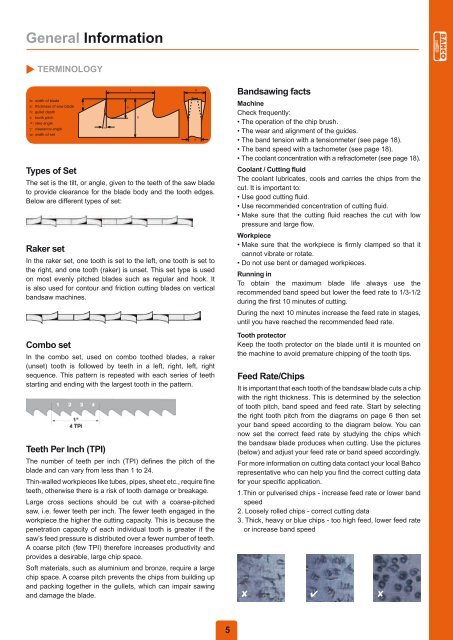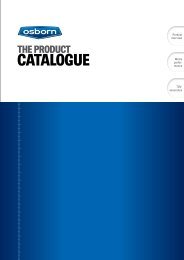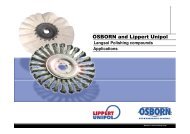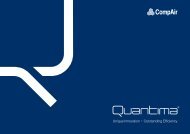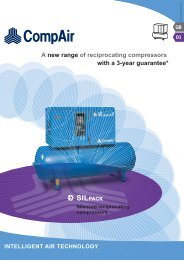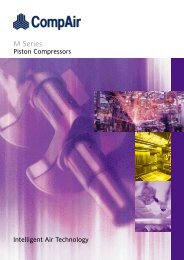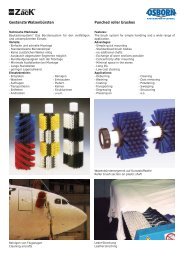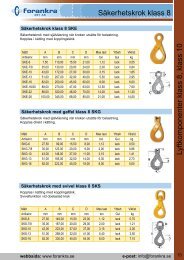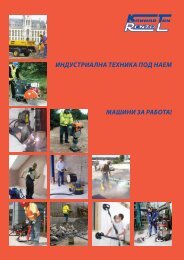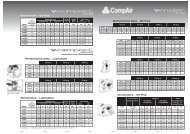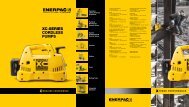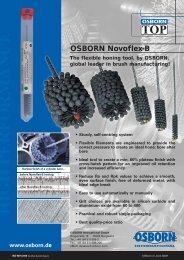Create successful ePaper yourself
Turn your PDF publications into a flip-book with our unique Google optimized e-Paper software.
General Information<br />
TERMINOLOGY<br />
b: width of blade<br />
s: thickness of saw blade<br />
h: gullet depth<br />
t: tooth pitch<br />
∝: rake angle<br />
γ: clearance angle<br />
w: width of set<br />
Types of Set<br />
The set is the tilt, or angle, given to the teeth of the saw blade<br />
to provide clearance for the blade body and the tooth edges.<br />
Below are different types of set:<br />
Raker set<br />
In the raker set, one tooth is set to the left, one tooth is set to<br />
the right, and one tooth (raker) is unset. This set type is used<br />
on most evenly pitched blades such as regular and hook. It<br />
is also used for contour and friction cutting blades on vertical<br />
bandsaw machines.<br />
Combo set<br />
In the combo set, used on combo toothed blades, a raker<br />
(unset) tooth is followed by teeth in a left, right, left, right<br />
sequence. This pattern is repeated with each series of teeth<br />
starting and ending with the largest tooth in the pattern.<br />
Teeth Per Inch (TPI)<br />
γ<br />
∝<br />
The number of teeth per inch (TPI) defines the pitch of the<br />
blade and can vary from less than 1 to 24.<br />
Thin-walled workpieces like tubes, pipes, sheet etc., require fine<br />
teeth, otherwise there is a risk of tooth damage or breakage.<br />
Large cross sections should be cut with a coarse-pitched<br />
saw, i.e. fewer teeth per inch. The fewer teeth engaged in the<br />
workpiece the higher the cutting capacity. This is because the<br />
penetration capacity of each individual tooth is greater if the<br />
saw’s feed pressure is distributed over a fewer number of teeth.<br />
A coarse pitch (few TPI) therefore increases productivity and<br />
provides a desirable, large chip space.<br />
Soft materials, such as aluminium and bronze, require a large<br />
chip space. A coarse pitch prevents the chips from building up<br />
and packing together in the gullets, which can impair sawing<br />
and damage the blade.<br />
h<br />
t<br />
b<br />
w<br />
s<br />
Bandsawing facts<br />
Machine<br />
Check frequently:<br />
• The operation of the chip brush.<br />
• The wear and alignment of the guides.<br />
• The band tension with a tensionmeter (see page 18).<br />
• The band speed with a tachometer (see page 18).<br />
• The coolant concentration with a refractometer (see page 18).<br />
Coolant / Cutting fluid<br />
The coolant lubricates, cools and carries the chips from the<br />
cut. It is important to:<br />
• Use good cutting fluid.<br />
• Use recommended concentration of cutting fluid.<br />
• Make sure that the cutting fluid reaches the cut with low<br />
pressure and large flow.<br />
Workpiece<br />
• Make sure that the workpiece is firmly clamped so that it<br />
cannot vibrate or rotate.<br />
• Do not use bent or damaged workpieces.<br />
Running in<br />
To obtain the maximum blade life always use the<br />
recommended band speed but lower the feed rate to 1/3-1/2<br />
during the first 10 minutes of cutting.<br />
During the next 10 minutes increase the feed rate in stages,<br />
until you have reached the recommended feed rate.<br />
Tooth protector<br />
Keep the tooth protector on the blade until it is mounted on<br />
the machine to avoid premature chipping of the tooth tips.<br />
Feed Rate/Chips<br />
It is important that each tooth of the bandsaw blade cuts a chip<br />
with the right thickness. This is determined by the selection<br />
of tooth pitch, band speed and feed rate. Start by selecting<br />
the right tooth pitch from the diagrams on page 6 then set<br />
your band speed according to the diagram below. You can<br />
now set the correct feed rate by studying the chips which<br />
the bandsaw blade produces when cutting. Use the pictures<br />
(below) and adjust your feed rate or band speed accordingly.<br />
For more information on cutting data contact your local Bahco<br />
representative who can help you find the correct cutting data<br />
for your specific application.<br />
1.Thin or pulverised chips - increase feed rate or lower band<br />
speed<br />
2. Loosely rolled chips - correct cutting data<br />
3. Thick, heavy or blue chips - too high feed, lower feed rate<br />
or increase band speed<br />
✘<br />
✔<br />
✘<br />
5


